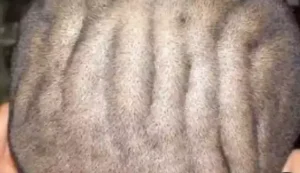Here is The Reason Why Some People Have Wrinkles on their Head

Cutis verticis gyrata (CVG), also known by the name paquidermia verticis gyrata, cutis verticis plicata, and “bulldog” scalp syndrome, is a rare benign cutaneous disorder that is characterized by convoluted folds and deep furrows of the scalp that mimic cerebral sulci and gyri.
What is the cause of cutis verticis gyrata? Cutis verticis gyrata is the result of overgrowth of the scalp skin. It can be classified as: Primary essential cutis verticis gyrata: no other associated abnormalities
In cutis verticis gyrata the skin gradually thickens, forming a variable number of folds and furrows that resemble the cerebral cortex. In most cases, the folds are parallel and run in an anteroposterior.
direction, though they may also be transverse in the occipital region.2–5 A distinctive feature of this condition is the impossibility of leveling the folds through traction or pressure. The areas affected may differ between individuals; lesions usually develop on the vertex of the scalp, though the temporal, frontal, and occipital regions can occasionally be involved.
Hair loss can occur over time where the scalp thickens, though hair within any furrows remains normal. Thus far, due to the (apparent) rarity of the condition, limited research exists and causes are as yet undetermined. What is known, is that the condition is not exclusively congenital.
The condition was first reported by Jean-Louis-Marc Alibert in 1837, who called it cutis sulcata.A clinical description of the condition was provided by Robert[who?] in 1843 and it was named by Paul Gerson Unna in 1907.It has also been called Robert-Unna syndrome, bulldog scalp, corrugated skin, cutis verticis plicata, and pachydermia verticis gyrata
The appearance of the skin folds in secondary CVG may be more asymmetrical and can appear at any age. Acromegaly and pachyodermoperiostosis (idioathic hypertrophic osteoarthorpathy) are two conditions that often present with secondary CVG Chromosomal abnormalities such as Turner syndrome, Klinefelter syndrome, and fragile X have also been associated with CVG. The only known familial form of CVG occurs in association with primary pachyodermoperiostosis.
Although CVG may be disfiguring, the process is essentially benign and no intervention is required
Who gets cutis verticis gyrata?
Cutis verticis gyrata occurs more commonly in males than in females. The primary form of cutis verticis gyrata has a reported male-to-female ratio of 5:1. The incidence of cutis verticis gyrata may be reported as lower in women because longer hair may camouflage the condition.
Most primary cases develop after puberty and typically occur before age 30 years. Some secondary forms of cutis verticis gyrata, such as cerebriform intradermal naevus, can be present at birth.
Large, folding lesions on the scalp that resemble cutis verticis gyrata are typically linked with hypertrichosis, but they can also have sparsely covered hair.
What is the primary cause of the illness?
Main factor Although there is no known aetiology for CVG, endocrinological and genetic factors are likely to play a part in the condition’s development.
There is a connection between primary non-essential CVG and neurological disorders like epilepsy and schizophrenia.
Some of them are the reasons that are given below:
1.Acromegaly.
2.Melanocytic naevi in moles
3. Birthmarks such fibromas, connective tissue nevi, and naevus lipomatosus.
4. Inflammatory conditions (including impetigo, eczema, psoriasis, folliculitis, acne, and Darier disease).




